Involving children in setting the priorities for research in pediatric diseases
- 15 October 2021
- 5 min read
The Juvenile Idiopathic Arthritis (JIA) PSP team in the Netherlands (Christine Dedding, Karijn Aussems & Casper Schoemaker) has kindly updated us on their experience of exploring how to engage children in a PSP. They have just published their final report and what follows here is a summary of what they found. Their detailed papers include references to the supporting information they build upon on how to involve children across the phases of the PSP.
Introduction
Engagement of children and adolescents is crucial in the James Lind Alliance Priority Setting Partnerships (JLA PSPs) for pediatric diseases. For these young patients an online survey might not suffice. Young patients might need time to get acquainted with the idea of being an expert in relation to what for them is a rather abstract world. Actually, this felt distance might also be true for people with a short or more practical education background. Therefore, lessons learned might be valuable for reflecting more broadly on how to engage people with different competencies in a PSP.

Christine Dedding

Karijn Aussems

Casper Schoemaker
Gathering uncertainties from children
Uncertainties are typically gathered via an online survey hosted on or linked to the PSP website. Unfortunately, children up to 13 years might be excluded from these online surveys due to lack of access or skills. In our online survey no more than 23% of responding patients were younger than 16 years. Some of these children were assisted by their parents, and therefore may have been influenced by what adults see as worthwhile or important.
To hear the voices of children, two focus groups and 6 small (group) interviews were held with children in an exploratory, creative and conversation-like manner, guided by an expert in child participation (CD). The two focus group discussions were held at the annual patient information day of the Dutch Juvenile Arthritis Association (November 2018). Later we conducted additional interviews at two pediatric rheumatology centers (March 2019) to involve more and younger children, and to ensure engagement of non-members of a patient organization. A cartoon was used to communicate the aims of the project. We explained that researchers need to know what it means to live with JIA, what challenges children experience and what research they think needs to be done to improve their (everyday) lives, in order to conduct research that is relevant to them.
During both the focus group discussions and interviews, we first took a moment for the children to familiarize with the researchers and each other, with the help of a warm-up activity. To ensure that children are not alienated from their own experiences and lives in the process, we used images that represent different domains of their lives as a starter, e.g. home, school, hospital and free time. In total 24 children, participated. Together, they formulated 81 uncertainties that were added to the over 500 uncertainties from the online survey.
Interim priority setting by children
The Steering Group formulated 53 summary questions. This number is hard for children to manage. Moreover, some of these summary questions were rather technical questions. Therefore, we selected the summary questions based on the input of children in the first phase; 23 of these 53 summary questions were based on at least one of the 81 uncertainties the children had brought up. Furthermore, the small number of children who had participated in the online or hardcopy survey also delivered uncertainties which had been categorized under five extra summary questions. This led to a total of 28 summary questions (53% of all summary questions) based on concerns raised directly by children. These 28 summary questions were rewritten in less abstract and more child friendly language and clustered into twelve themes (CD and CS).
Two focus groups, and a subsequent group priority setting discussion, were held at the annual patient information day of the patient organization (November 2019). This resulted in a top 5 of their most important summary questions:
The Children's Top 5:
1. What is the influence of JIA on future opportunities regarding school results, work and relationships?
2. Why are children with JIA fatigued more quickly, what can be done about it, and how can one cope with the fatigue in daily life?
3. How can pain best be recognized and be treated (with medication), and what action can a patient take him/herself?
4. How can pills be manufactured in such a way that they are easy to take? (i.e. shape, color, taste)
5. What is the best way to practice your favorite sport safely?
The Steering Group added this Top 5 to the Top 10s of patients, carers and clinicians. Three questions in the childrens’ top 5 – numbers 3, 4 and 5 – were ranked much lower by the other three groups. This illustrates the added value of engaging children themselves.
Should we invite children to the final priority setting?
The children were not invited for the final priority setting workshop, as the Steering Group at that time felt they would not have an equal say there. We hoped the young adult patients would advocate for them. And they did. One question of the final Top 10 made it into the list because a young adult patient advocated for it during the final discussion, using the argument that it was the children’s top priority. We invite the JLA and future PSPs on pediatric diseases to explore ways to engage children in future final priority setting workshops as this does justice to them as problem owners. Moreover, otherwise they remain dependent on wise others, who have their own perspectives on what counts as valuable.
Takeaway findings
- Uncertainties are typically gathered via an online survey hosted on or linked to the PSP website. Unfortunately, children up to 13 years might be excluded from these online surveys due to lack of access or skills.
- In focus groups and small (group)interviews children can formulate research uncertainties that can be added to the results of the online survey.
- We showed that with proper guidance and starting from their lifeworld, children can become genuine partners in a PSP.
- We invite the JLA and future PSPs on pediatric diseases to explore ways to engage children in future Final Priority Setting workshops as this does justice to them as problem owners.

The picture shows children during the interim agenda setting. They view the envelopes with the main themes and write down their personal preferences
References:
Aussems, K., Schoemaker, C. G., Verwoerd, A., Ambrust, W., Cowan, K., & Dedding, C. (2021). Research agenda setting with children with juvenile idiopathic arthritis: Lessons learned. Child: Care, Health and Development, 1– 12. https://doi.org/10.1111/cch.12904
Schoemaker, C.G., Armbrust, W., Swart, J.F. et al. Dutch juvenile idiopathic arthritis patients, carers and clinicians create a research agenda together following the James Lind Alliance method: a study protocol. Pediatr Rheumatol 16, 57 (2018). https://doi.org/10.1186/s12969-018-0276-3
Verwoerd, A., Armbrust, W., Cowan, K. et al. Dutch patients, caregivers and healthcare professionals generate first nationwide research agenda for juvenile idiopathic arthritis. Pediatr Rheumatol 19, 52 (2021). https://doi.org/10.1186/s12969-021-00540-2


